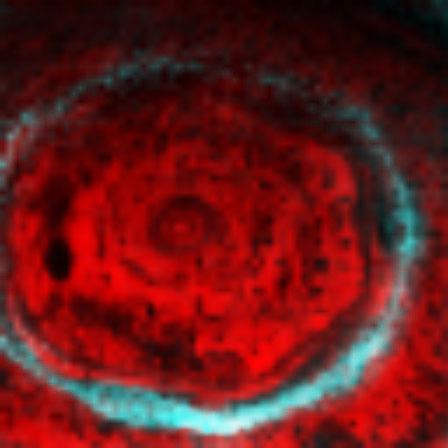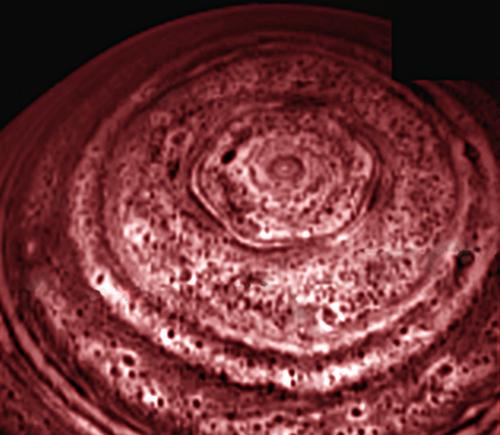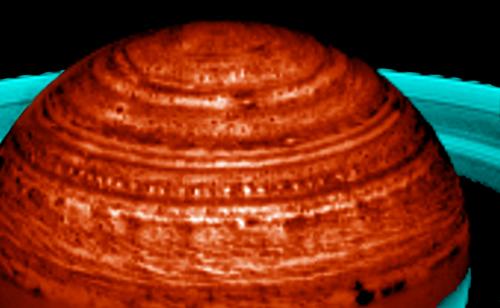|
The Enigmas on Saturn |
|
|
PIA09185: Saturn's North Pole Hexagon and Aurora .
Click on image for tiff format Spacecraft:
Cassini
Orbiter
Written by University
of Arizona / LPL
This nighttime view of Saturn's north pole by the visual and infrared mapping spectrometer on NASA's Cassini orbiter reveals a dynamic, active planet at least 75 kilometers (47 miles) below the normal cloud tops seen in visible light. Clearly revealed is the bizarre six-sided hexagon feature present at the north pole. This image is one of the first clear images of the north polar region ever acquired from a unique polar perspective. In this image, the blue color shows high-altitude emissions from atmospheric molecules excited by charged particles smashing into the atmosphere along Saturn's powerful magnetic field lines, producing the aurora at very high altitudes in Saturn's atmosphere. The red color indicates the amount of 5-micron wavelength radiation, or heat, generated in the depths of the warm interior of Saturn that escapes the planet. Clouds blocking this light are revealed as silhouettes against the background thermal glow of the planet. This image is among the first to capture the entire hexagonal feature and north polar region in one shot. It is also one of the first polar views using Saturn's thermal glow at 5 microns (seven times the wavelength visible to the human eye) as the light source. This allows polar cloud features to be revealed during the persistent nighttime conditions under way during north polar winter. The hexagonal feature was originally discovered by NASA's Voyager spacecraft in 1980, but those images and subsequent ground-based telescope images suffered from poor viewing perspectives, which placed the feature and the north pole at the extreme northern limb (edge) in those images. The strong brightness of the hexagon feature indicates that it is primarily a clearing in the clouds, which extends deep into the atmosphere, at least down to the 3-bar (3-Earth atmospheres pressure) level, about 75 kilometers (47 miles) below the clouds and hazes seen in visible wavelengths. Thick clouds border both sides of the narrow feature, as indicated by the adjacent dark lanes paralleling the bright hexagon. This image and other images acquired over a 12-day period between Oct. 30 and Nov. 11, 2006, show that the feature is nearly stationary, and likely is an unusually strong pole-encircling planetary wave that extends deep into the atmosphere. This image was acquired by the Cassini visual and infrared mapping spectrometer on Oct. 29, 2006, from an average distance of 905,000 kilometers (562,340 miles) above the clouds. The Cassini-Huygens mission is a cooperative project of NASA, the European Space Agency and the Italian Space Agency. The Jet Propulsion Laboratory, a division of the California Institute of Technology in Pasadena, manages the mission for NASA's Science Mission Directorate, Washington, D.C. The Cassini orbiter was designed, developed and assembled at JPL. The Visual and Infrared Mapping Spectrometer team is based at the University of Arizona, where this image was produced. For more information about the Cassini-Huygens mission visit http://saturn.jpl.nasa.gov/home/index.cfm. The visual and infrared mapping spectrometer team homepage is at http://wwwvims.lpl.arizona.edu. |
|
|
PIA09188: Saturn's Active North Pole .
Click on image for tiff format
Spacecraft:
Cassini
Orbiter
Written by University
of Arizona / LPL
A bizarre six-sided feature encircling the north pole of Saturn near 78 degrees north latitude has been spied by the visual and infrared mapping spectrometer on NASA's Cassini spacecraft. This image is one of the first clear images ever taken of the north polar region as seen from a unique polar perspective. Originally discovered and last observed by a spacecraft during NASA's Voyager flybys of the early 1980's, the new views of this polar hexagon taken in late 2006 prove that this is an unusually long-lived feature on Saturn. This image is the first to capture the entire feature and north polar region in one shot, and is also the first polar view using Saturn's thermal glow at 5 microns (seven times the wavelength visible to the human eye) as the light source. This allows the pole to be revealed during the nighttime conditions presently underway during north polar winter. Previous images from Voyager and from ground-based telescopes suffered from poor viewing perspectives, which placed the feature and the north pole at the extreme northern limb (edge) of the planet. To see the deep atmosphere at night, the infrared instrument images the thermal glow radiating from Saturn's depths. Clouds at depths about 75 kilometers (47 miles) lower than the clouds seen at visible wavelengths block this light, appearing dark in silhouette. To show clouds as features that are bright or white rather than dark, the original image has been contrast reversed to produce the image shown here. The nested set of alternating white and dark hexagons indicates that the hexagonal complex extends deep into the atmosphere, at least down to the 3-Earth-atmosphere pressure level, some 75 kilometers (47 miles) underneath the clouds seen by Voyager. Multiple images acquired over a 12-day period between Oct. 30 and Nov. 11, 2006, show that the feature is nearly stationary, and likely is an unusually strong pole-encircling planetary wave that extends deep into the atmosphere. This image was acquired on Oct. 29, 2006, from an average distance of 902,000 kilometers (560,400 miles) above the cloud tops of Saturn. For more information about the Cassini-Huygens mission visit http://saturn.jpl.nasa.gov/home/index.cfm. The visual and infrared mapping spectrometer team homepage is at http://wwwvims.lpl.arizona.edu. |
|
|
. Click on image for tiff format In this image, Saturn's fascinating meteorology manifests itself in a "string of pearls" formation, spanning over 60,000 kilometers (37,000 miles). Seen in new images acquired by Cassini's visual and infrared mapping spectrometer and lit from below by Saturn's internal thermal glow, the bright "pearls" are actually clearings in Saturn's deep cloud system. More than two dozen occur at 40 degrees north latitude. Each clearing follows another at a regular spacing of some 3.5 degrees in longitude. This is the first time such a regular and extensive train of cloud-clearings has been observed. The regularity indicates that they may be a manifestation of a large planetary wave. Scientists plan to take more observations of this phenomenon over the next few years to try to understand Saturn's deep circulation systems and meteorology. This image was taken on April 27, 2006. The Cassini-Huygens mission is a cooperative project of NASA, the European Space Agency and the Italian Space Agency. The Jet Propulsion Laboratory, a division of the California Institute of Technology in Pasadena, manages the mission for NASA's Science Mission Directorate, Washington, D.C. The visual and infrared mapping spectrometer team is based at the University of Arizona where this image was produced. SOURCE: NASA
|
|
| FAIR USE NOTICE: This page contains copyrighted material the use of which has not been specifically authorized by the copyright owner. Pegasus Research Consortium distributes this material without profit to those who have expressed a prior interest in receiving the included information for research and educational purposes. We believe this constitutes a fair use of any such copyrighted material as provided for in 17 U.S.C § 107. If you wish to use copyrighted material from this site for purposes of your own that go beyond fair use, you must obtain permission from the copyright owner. | |
|
|



